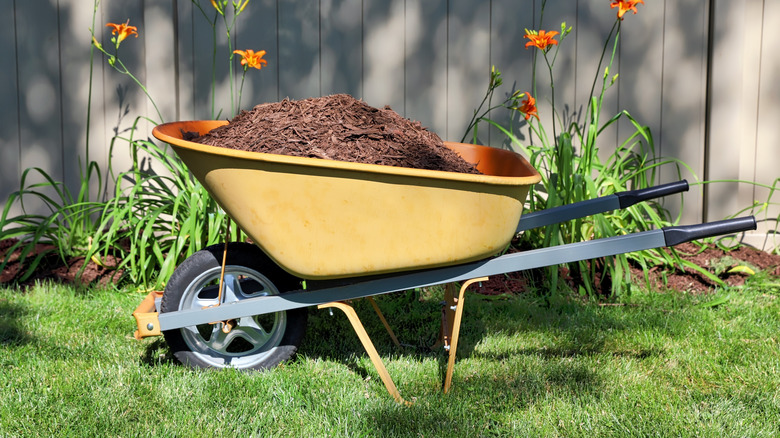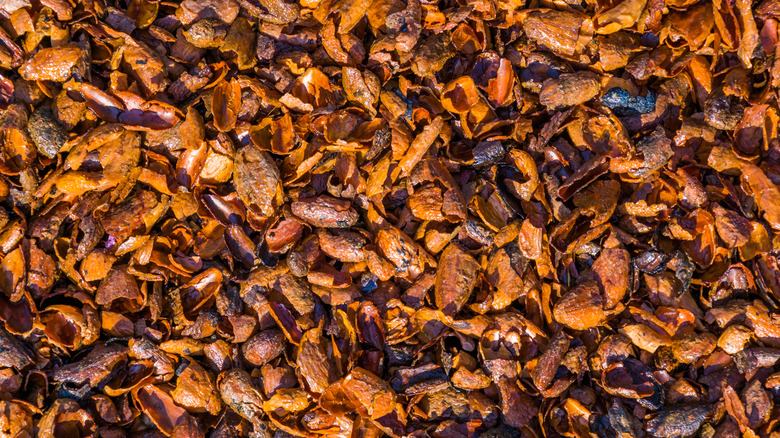Should You Mulch Your Garden With Cocoa Hulls? What You Need To Know
We may receive a commission on purchases made from links.
Mulching is a great way to provide a host of benefits to your garden. While there are many different types, one you may not be familiar with is cocoa hull mulch. Cocoa hulls are the shells of cocoa beans and are often byproducts of making chocolate or cocoa products. Reusing these ingredients as mulch can be beneficial in several ways. For one, cocoa shells are a beautiful, dark color that can enhance the aesthetic appeal of your garden or flower beds, contrasting with the green foliage of your plants. They're also a great alternative to using synthetically dyed mulches that may contain harmful chemicals that can leach into the surrounding soil. Another great reason to choose them is because they are lightweight and easy to spread, making them convenient to work with and perfect for those with mobility limitations.
Cocoa hull mulch can block out weeds by forming a barrier over the soil and preventing them from receiving sunlight. As a result, the weeds won't be able to steal nutrients from the other plants in your garden, and you can skip the hassle of manual weeding. What's also great about cocoa shells is that they can enrich the soil as they slowly break down, helping to improve soil structure and fertility. Finally, like most mulches, they help to retain moisture in the soil, preventing rapid evaporation and reducing the frequency of your watering schedule.
How to mulch with cocoa hulls
Fortunately, if you've mulched your yard or garden before, using cocoa hulls instead of a traditional product isn't all that different. Before unloading the cocoa shells, make sure the desired area is clear of debris and weeds. You'll also need to determine how much of this mulch to purchase based on the size of the area you're looking to cover. While your local nursery should carry this product in bags, you can also check out hardware stores like Lowe's and Home Depot. Amazon even sells a bag of 2 cubic feet for $38.45.
Once you've secured your shells, spread them in an even layer over the soil surface. Aim for a thickness of 1 to 3 inches and be careful not to pile the mulch too close to the base of plants or trees as it may inadvertently cause rot or diseases. Instead, leave a small gap around the stems and trunks to increase airflow. When you've finished spreading out your mulch, gently rake the husks to ensure an even distribution, smoothing out any uneven areas. Settle the mulch by watering it thoroughly. You'll also activate their aromatic scent. Monitor your cocoa hull mulch throughout the season to be sure rain and wind don't displace any coverage, and add more hulls as it decomposes to maintain complete groundcover.
Cautions for this method
Though cocoa hulls offer many benefits as an alternative mulch for your garden, there are some cautions to consider before incorporating it into your gardening routine. One primary concern is that cocoa hulls can be toxic to pets, especially dogs. The shells contain theobromine and caffeine, which can poison them if they ingest enough of the mulch. Since the hulls have such a distinct smell, your furry friend may mistake them for food and eat them, resulting in gastrointestinal discomfort, tremors, seizures, or even death. If you have a dog or there are dogs nearby, it may be best to consider a different type of mulch that is more pet-friendly.
Another consideration is that cocoa hulls decompose more slowly than traditional mulches, which reduces the importance of replacing them. But sometimes their durability can create a thick mat over the soil, impeding water filtration and air exchange. As a result, the soil can become waterlogged and oxygen may not reach plant roots, harming their health. It may be a good idea to agitate this type of mulch a few times throughout the growing season to be sure that water and airflow are proficient. On this note, cocoa hulls are known to harbor mold spores, especially in humid or damp conditions. Consider mixing in some cinnamon as a natural anti-fungal (it'll elevate your mulch's aromatics too).

